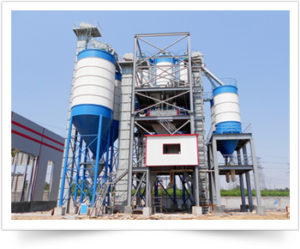For the most part, people understand that a dry mortar mix plant for sale is designed and meant to produce a range of mortars – from the ordinary mortar to the specialty mortar. Suffice to say, you need this plant if plan to produce thermal insulation mortar, tile adhesive mortar, waterproof mortar, masonry mortar, wear-resisting mortar, plastering mortar, and much more.
As such, these plants have become a quite popular investment for people and businesses plying their trade in the construction business. As an investment, you are almost assured of accruing profits if you have a ready market and you manage your business the right way. However, not many people have a clue as to the various parts that constitute a dry mortar mix plant. With this in mind, herein we will explore the various components of such a plant with a focus on medium to large-scale plants.
#1. Cement silo – The cement silo for sale is the main storage vessel used in storing cement. The silo size varies according to plant specification. However, it always performs the function of storing cement. Therefore, plant operators can purchase cement in bulk and store it in this vessels, thereby allowing them to benefits form the economies of scale involved in bulk purchases of cement.

#2. Sand dryer – The sand dryer is used to remove moisture content to the required levels for a particular mortar product. Each type of mortar requires precise control of moisture, cement, and sand in the mix. To ensure that the moisture content is uniform and at the recommended level, drying of the sand is necessary first.
#3. Trommel screen – This component of the dry mortar production line is used to separate sand particles of various sizes, leaving behind the particles that fit the set criteria. This component makes it easy for the plant to produce a variety of mortar products fast and relatively straightforward.
#4. Dry mortar mixer – This is usually a drum-like mixture wherein the right proportions of sand and cement are put in and thoroughly mixed. In many regards, this is the central focus of the plant as everything else is done in preparation for the mixing. Every other component in the plant functions to make the process of mixing as efficient as possible, therefore, producing the desired mortar products.
#5. Bucket Elevator – The bucket elevator is used to feed sand to the sand dryer. It is a necessary component for the purpose of making the plant efficient in its operations and enhancing continuous operations.
#6. Screw conveyor
Additionally, based on the level of automation, you can expect to have other components that carry out various tasks. For instance, there are the computer control systems which control the entire plants from a single point or from a few nodes.
In the case of a portable dry mortar mixing plant, you can expect the plant to have components that will aid mobility and ease of set-up. Since portable plants are designed to be easy to relocate with short notice, the plant is divided into various sections, with each section being easy to tow.